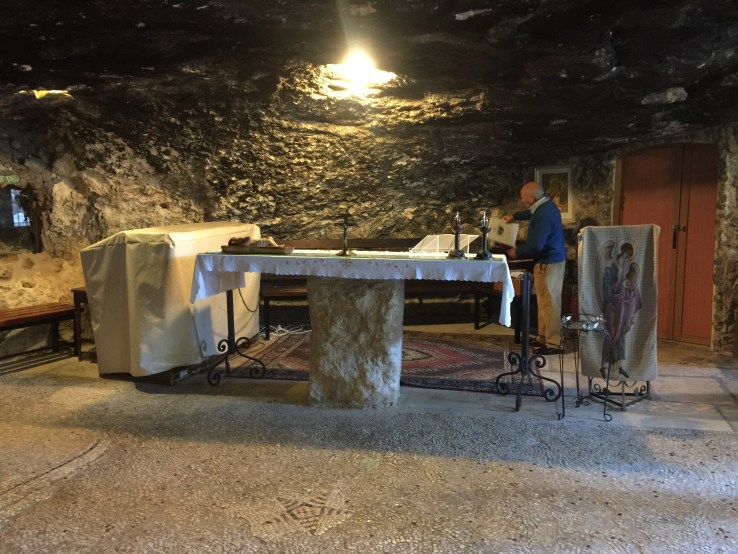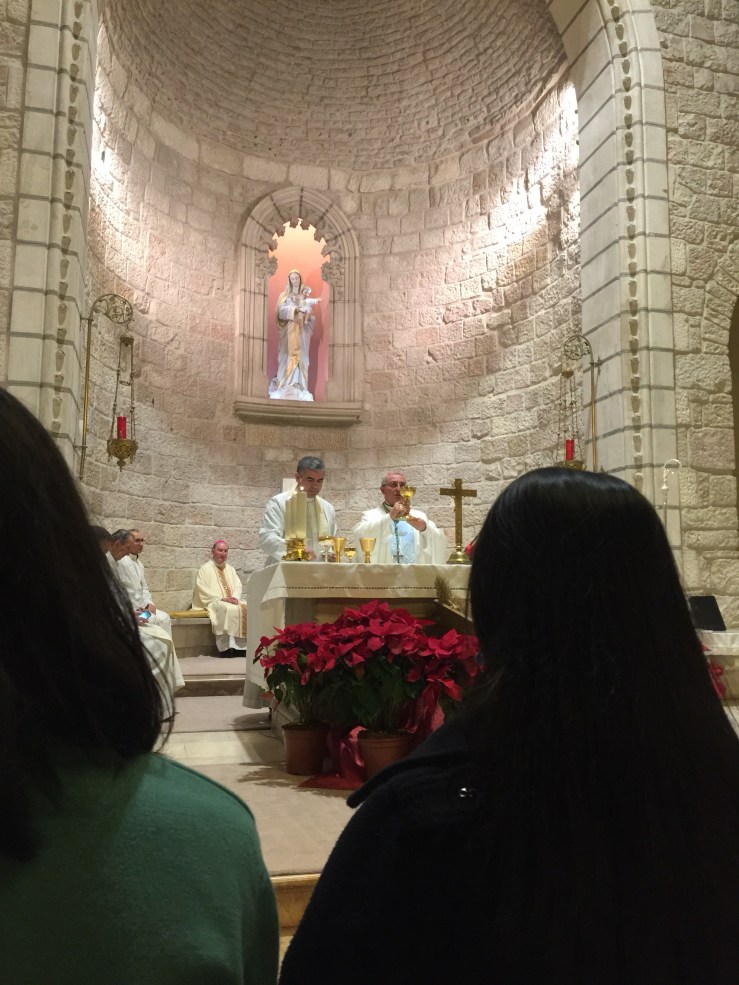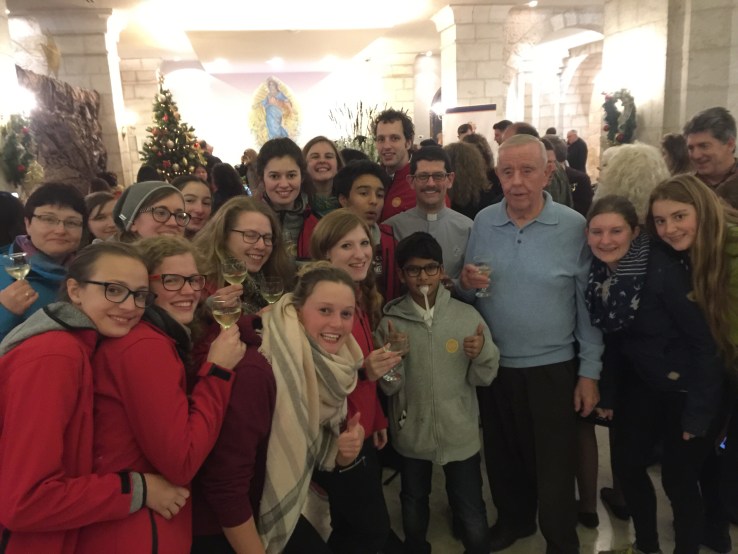Today was another really wonderful day, and very eye opening on several fronts.
The first thing on our itinerary was to depart for Bethlehem. Bethlehem is only about three miles away, but took about 40 minutes to get there. The reason is the large wall that keeps the Palestinian areas separated from the rest of Jerusalem. I’ve heard about the wall. I’ve seen pictures of the wall. I’ve read articles and commentary about the wall. I’ve tried to understand what it really is all about. Today … I saw the wall up close. What I saw made me sad that we can’t find a way to live in peace with our brothers and sisters. You can see a sample of the wall below.
We had to drive far out of our way to a checkpoint to cross into Palestine. Once inside, we quickly arrived at a shop that sells everything from high-end antiquities down to Olive Wood trinkets, and everything in between. The shop owner has an amazing story to tell about the Dead Sea scrolls.

The owner of the shop is the grandson of the man who originally discovered the Dead Sea scrolls. He gave us the full story about the scrolls, their discovery, and filled in some details I’d never heard before. In the past, I’ve read quite a bit about the scrolls. The story I’ve heard is that the scrolls were found by some boys who were throwing rocks into some caves while looking for their goats or sheep. These “boys” threw a rock into the cave and heard a crash, leading to the discovery of the pots that held the scrolls.
Here’s a short version what really happened. This man’s grandfather was a bit of an amateur antiquities dealer. He wanted some men to go explore some caves nearby to see what could be found. These caves were hard to reach because of where they were located on a mountain side. These men worked in the nearby fields and their trade name is something akin to “cowboy”, except for sheep and goats (This is where the story about “boys” looking for goats comes from). It took about two years to convince these two men to explore the caves because they were superstitious and thought that the caves might have spirits living in them. So before they finally mustered up the courage, they got to the cave opening and threw rocks in to see if it was safe or if evil spirits would be there. That’s when they heard the famous “crunch” of pottery breaking, which led to the discovery of the scrolls.
There is a lot more to the story about how the scrolls ended up in the hands of the government, but I’ll skip that because I don’t know if I can accurately remember the details.
Although most of the scrolls were removed from him, his grandfather was allowed to hold onto one pot containing one of the scrolls. It is in the case right behind him. Wow. Really interesting and well worth the trip to the shop!
In the picture below, he is holding a “tear jar”. The women of Roman times would collect their tears into these jars and send them off with their husbands when they went for war. These were considered more precious than perfumes. They were a sign of the love from the woman to her husband. If the husband were to die in battle, the tears would be buried with him.
In the Luke 7:36-50, we hear about a sinful woman who comes to Jesus and bathes His feet with her tears, dries them with her hair, anoints them, and kisses them. It is likely that she was not just crying over His feet. She was giving her most precious possession, her collected tears, by pouring them out of a tear-jar onto His feet. She is expressing her deep love for Jesus.

I was very attracted to some of the antiquities, but decided that I couldn’t afford them. One thing I really considered: they had many Roman era coins there. I was really impressed by the “Widow’s Mite” coins. We read about the small copper coins in Luke 21:1-4, but seeing them made me think even more about how minuscule they were. Imagine a small shirt button on a typical man’s shirt, about 1/2 as thin. Minuscule and small. Not worth much of anything. Imagine that being all you had to live on. You’d have to trust God a lot with your life if that’s all you had. There were some other coins that were also made into jewelry that I tried to get a picture of below.


I took a picture of a really neat olive-wood setting of the Last Supper. Our guide explained that this is a pretty accurate understanding of how a first-century Passover meal would have been laid out:
The meal is a celebration meal, eaten reclining on their left elbows (The Passover is a celebration meal). The table is U shaped so that the Host can see everyone and talk with everyone and food can be served from in front of each guest instead of walking over their reclined bodies. The host (Jesus in this case) sits at the head (left side, center) so that he can see when someone has an empty plate. An empty plate means that you need more food. Leaving a little food means you are done. The youngest sits to his right and would be dispatched to serve the food at the host’s request (John sits to Jesus right on the bottom left). Prime guests sit across from the host (Peter sits across) so that the host can talk most easily with them. Peter can communicate easily with John since he’s right across from him – so he can ask to find out who the traitor is. Judas sits next to Jesus, so he shares the morsel with Jesus.
This scene was a great teaching tool. I would have loved to bring it home, but it is about 4 feet by 2.5 feet in size and pretty costly.

After leaving there, our next stop was an orphanage in Palestine, run by the St. Vincent DePaul sisters. This was a powerful and moving experience. I loved it and it made me sad, too.
The orphanage is located next to a state-of-the-art birth OB/GYN hospital, the Holy Family Hospital, run by the Order of Malta, which serves the poor women in Palestine. This orphanage helps young Palestinian women, nearly all Muslim, who have pregnancies before marriage. Some are by sex before marriage, and many are by non-consensual intercourse – sometimes with family members. To be found pregnant outside of marriage is a source of shame and can be dangerous, especially if it involves family members who want to cover up their sinful behavior. So the orphanage takes in the pregnant mothers and cares for them until their babies are born. After birth, the mother leaves and the orphanage takes care of the children until they are 7, then they are turned over to the government in an arrangement that sounds much like the foster care system in the U.S.
The sisters care for these youngsters and raise them. They can not teach them about the Catholic Faith because the government says that these children must be raised Muslim. But what the kids receive is an outpouring of Christ’s love – in the orphanage that is only about 800 yards away from the place where Jesus was born. We watched the sisters taking care of the kids and they were loving those children the same way a mother would take care of her own child. It was quite touching.
One other neat thing: they celebrate Christmas every day that they bring a new baby home. In this town where Jesus was born, how fitting it is that welcoming an orphan into their home is greeted with great love and celebration.



We played with the kids, took some toys for them, and soaked up the wonderful environment. I got some 1:1 time with an infant who just stared into my eyes with her beautiful dark eyes and gave me a little smile. At that moment, I would have signed anything needed to bring her home if I could. Unfortunately, the Palestine government does not allow for adoptions, so these children will be on their own after their period of foster care ends in their late teens.





Leaving the orphanage, we made the short trip to the Church of the Nativity, the place where Jesus was born. This is a Greek Orthodox Church that undergoing a very heavy restoration that looks like it will take many years. Along the way as we walked, I saw this interesting coffee shop. I think they have a catchy name – perhaps they should consider franchising.

The door to the church is very small. It was originally much taller but was shortened to keep men from riding horses and camels into the church. Then it was lowered again to make sure you bow down as you enter.

You have to wait in a long line to get to the place where Jesus was born. It took us about an hour. I snapped the following picture while waiting in line. You can see a small sampling of the multitude of icons and oil lamps – it’s Greek Orthodox, for sure! Some of the icons were quite beautiful.

So eventually you go down a staircase into a cave below the church. At the bottom, you find two important places: the place of Jesus’ birth, and the place where the manger was located. In the picture below, you can see the star with a large hole in it. Below the slab of marble and through the hole, you can touch the rock where Jesus was born. If you place religious articles against it, they become third-class relics. So I have some items coming home that are now third-class relics.

After you emerge from the cave, you come up on the other side of the main sanctuary space. Here’s a better shot of the main sanctuary. This is set up for the eastern-rite mass – notice the two sets of doors they’d use during liturgy.

There’s another very important thing in the Church’s history that happened here. Just outside the walls of the church, you find a statue of St. Jerome. I’ll give an incredibly over-abbreviated version of why. Jerome had been tasked with translating the Bible into Latin, which was the popular language of the time. He had done the New Testament and the Psalms of the Hebrew Scriptures – enough to facilitate having the Sacred Liturgy done in the vernacular. He wanted to complete the entire Hebrew Scriptures, so he came to Bethlehem to complete his work as a hermit. The completed work is what’s known as The Vulgate.

Leaving Bethlehem, you can see the settlements along the Shepherds’ Fields.


Lunch was awesome again. This time we started with about 10 appetizers, followed by chicken and lamb kabobs. Some people at our table also finished off lunch with some hookah. I took a pass.


This region is known as the Shepherds Fields. We saw some shanty areas where the shepherds live down in the valley too. This is the area where the Shepherds from Luke’s Gospel were watching over their flocks. About 2 miles away from the Church of the Nativity is the Shepherds Field church. We had mass in the cave where the Shepherds received the message from the angels to go to Bethlehem to find the infant and to deliver their message to Mary & Joseph. Next to the cave is a church that is built to look like a shepherd’s tent.





Here’s a panorama shot of the entire valley. Jerusalem is far off to the left in the distance. If you look carefully, you can also see the wall and its barbed wire top down in the valley.


We returned to our hotel and had a light bite to eat. Tonight is New Year’s Eve. It is also a special feast day tomorrow, celebrating Mary as the Mother of God. We went to a spectacular mass at 10:30PM to celebrate the vigil of the feast. The prime celebrant was the Papal Nuncio with many other priests concelebrating. It was really beautiful.


Afterwards there was a champagne celebration in the lobby. I ran into this young group of kids from Austria who are here from a group called Kisi Gods Singing Kids. One of the young men gave me about a 15 minute passionate discussion about the musical they have produced on the Book of Ruth. If our next generation is as excited as he is, our Church is in great hands.

Well, it’s 2:00AM here. Enough blogging, time for sleep.
May God grant you a restful night and a peaceful death. Amen.
Happy New Year!
– Deacon Matt

[…] Israel Day 4 – Bethlehem: About The God Child and Children of God […]